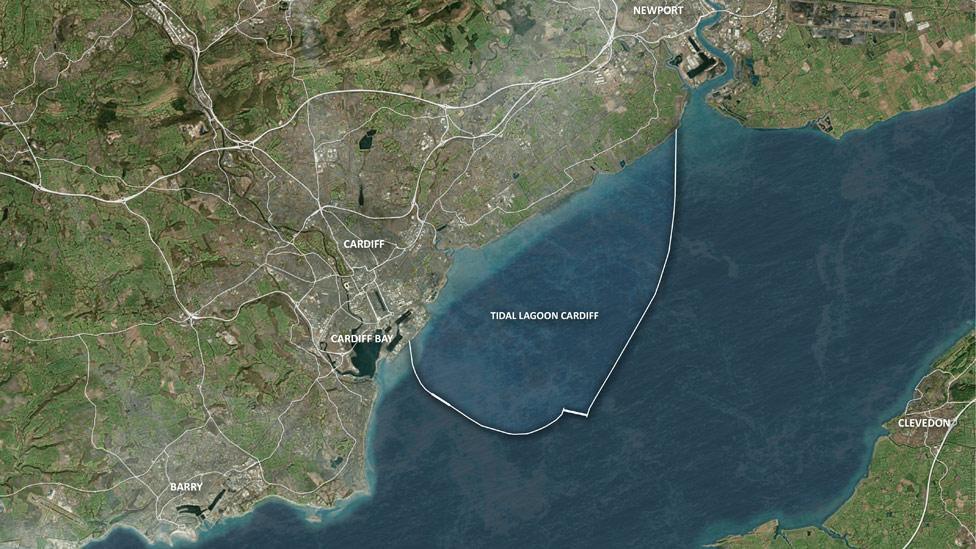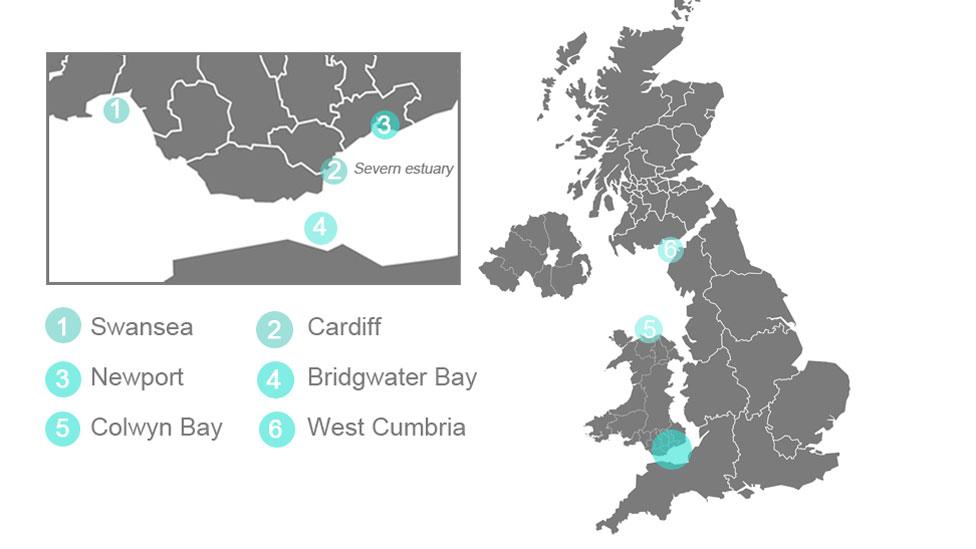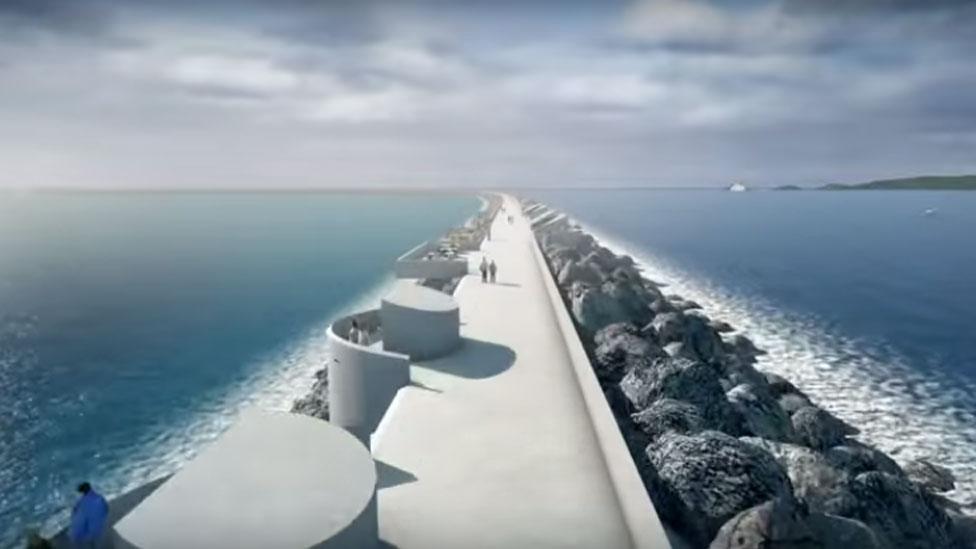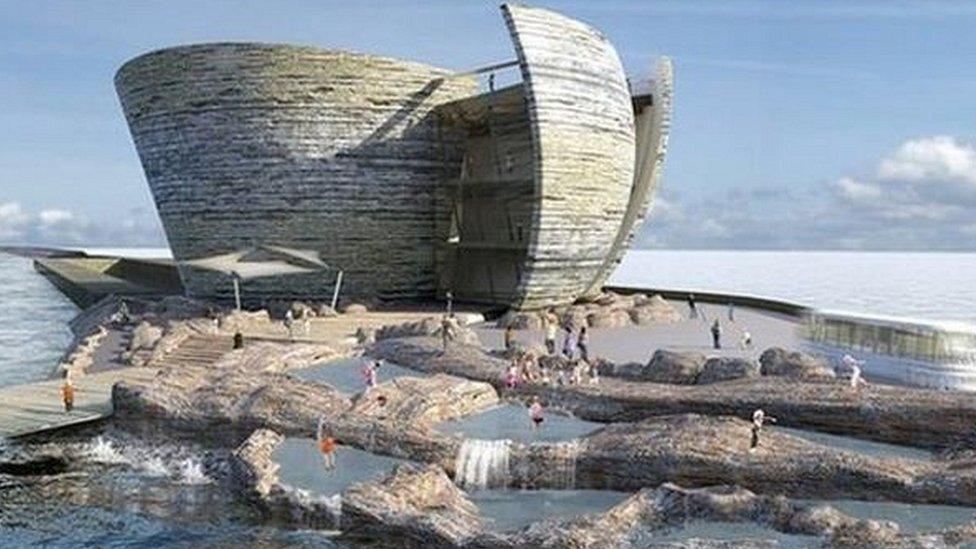£8bn tidal lagoon vision outlined to Cardiff council
- Published

Where the tidal lagoon proposed for Cardiff Bay would stretch
An £8bn tidal lagoon in Cardiff Bay would be big enough to provide enough electricity for the whole of Wales, council leaders have been told.
Cardiff council's cabinet has set up a taskforce to scrutinise the plans.
It would take seven years to build and be considerably bigger than one already planned for Swansea Bay.
But developers are waiting for a UK Government response to an independent review on tidal energy's viability.
Tidal Lagoon Power wants the first, smaller lagoon off Swansea to be a test bed for the technology.
But it believes full-scale projects - including other lagoons off Colwyn Bay, Newport and Bridgwater Bay off the Somerset coast - will both deliver energy at the right price and provide a beneficial economic impact.
It estimates the Cardiff lagoon would provide eight times the power of the Swansea project with a strike price of under £70.00 per MWh.
The capital cost is expected to be in the region of £8bn. This will be funded privately.
It would mean:
A breakwater which would be 13.5 miles (22km) long and the wall would be twice the length of the proposed Swansea lagoon
60 to 90 turbines
An installed capacity of 1,800-2,800 MW and annual output of 4-6 TWh would be "comfortably enough" to provide low carbon electricity to power every home in Wales
A life of 120 years and be able to operate 14 hours a day
Unlike the Swansea lagoon, the public would not be able to walk or cycle along the breakwater wall
The developers are already working on oceanographic, bird and fish surveys and scientific and engineering modelling.
If all goes well, plans are expected to be put forward in 2018 with the hope of a decision the following year.
Cardiff council - although it would not make the decision on the plans - has been told the lagoon could create 1,000 permanent jobs and be of "international significance".
It warned the council was potentially facing "a huge knowledge gap" when it came to dealing with a project on this scale.
Council leader Phil Bale told the meeting the council's environmental scrutiny committee was "well placed" to fulfil the role, and would gather "detailed information and offer clarity on potential opportunities and issues".
He said it would be wise for the council to wait for the conclusions of the independent review into tidal lagoons, commissioned by the UK Government and due to report by the New Year.
"Should its findings be positive then that would start to trigger further developments," he said.
"It's important that we consider all the possible implications for Cardiff and recognise that this is a project of international significance," Mr Bale told the meeting.
Councillor Ramesh Patel, cabinet member for transport, planning and sustainability added that "it could totally transform the city and put us on the world map in terms of clean energy".
"On paper it looks very, very good. But we will need to keep a very watchful eye on the environmental implications."
Cabinet members reflected on the fact that the last major project many of them had been involved with was the development of Cardiff City Stadium - though that had been "a lot of work" it seemed "minute" compared to what lay ahead with the tidal lagoon.


Analysis by Steffan Messenger, BBC Wales environment correspondent
Everything now rests on the outcome of an independent review commissioned by the UK Government into tidal energy.
Cardiff is where the developers will step up a gear if their "pathfinder" project in Swansea gets the green light.
It is also where the company's economic argument kicks in.
Their environmental pitch - the lagoons will have "a negligible impact on nature" and the UK will struggle to tackle climate change without tidal power.
For green groups it means wrestling with conflicting feelings: do they highlight potential implications on landscape and wildlife or focus on a sense that climate change trumps everything?

Max Wallis of Friends of the Earth in Barry and Councillor Paul Mitchell give their views
Councillor Paul Mitchell, chairman of Cardiff's environmental scrutiny committee, said the devil would be in the detail in what it means for the estuary.
"There's a lot for us to look at - it's obviously early days but we have a duty to ensure not only the economic benefits are in place but that the environmental impacts are properly assessed."
Early objectors include Barry and Vale Friends of the Earth, which is concerned about potential loss of habitat for birds and other wildlife and the way the lagoon's structure will affect sediment deposition in the shipping channels to Cardiff docks.
Keith Stockdale from the group told BBC Wales he was concerned the lagoon would "silt up and deoxygenate".
He also believes the lagoon will take too long to build and other smaller-scale renewable schemes such as tidal fences should be prioritised.
- Published7 November 2016

- Published7 November 2016

- Published10 February 2016
